Multistimuli responsive supramolecular polymer networks via host-guest complexation of pillararene-containing polymers and sulfonium salts
Feihong Lu,Yi Chen,Boqio Fu,Shigui Chen,*,Lu Wng ,*
a The Institute for Advanced Studies,Hubei Clinical Center&Key Lab of Intestinal&Colorectal Diseases,Wuhan University,Wuhan 430072,China
b Institute of Biomedical Materials Industry Technology,Hubei co-Innovation Center for Utilization of Biomass Waste,College of Chemistry and Materials Science,Hubei Engineering University,Xiaogan 432000,China
Keywords:
ABSTRACT A stimuli-responsive supramolecular polymer network has been constructed based on the host-guest interactions between the copolymer poly-P[5]A with pendent pillararene units and bis(sulfonium)diction guest G2.The formation mechanism of the supramolecular polymer network has been explored by the intensive study.With the addition of the competitive molecules and heating,the supramolecular polymer network could be dissociated and lead to clear changes in NMR spectroscopy and viscosity property.
Stimuli-responsive systems have been widely used in the field of functional materials due to their controllable properties upon external stimuli[1,2].Supramolecular polymer networks,constructed by polymers linked together with noncovalent interactions,have attracted great attention in the field of stimuli-responsive materials due to their reversibility and stimuli-responsiveness properties[3-5].In recent few years,various non-covalent interactions have been employed to construct supramolecular polymer networks,such as hydrogen bonding[6,7],electrostatic interactions[8],host-guest interactions [9-12],π-πstacking[13,14]and metal-ligand coordination[15,16].Among them,host-guest interactions have been given great attention,which are susceptive to external stimuli,including pH[17],ions[18],light[10],redox[19]and temperature[20].So these supramolecular polymer materials could be endowed with unique properties and tunability[3].To date,a variety of supramolecular polymer networks have been successfully fabricated based on the host-guest interactions involved by numerous macrocycles such as crown-ethers[17,18,21],cyclodextrins[22,23],calix[n]arenes[9,24]and cucurbit[n]urils[25,26],which provide a good strategy to prepare stimuli-responsive materials.
Pillar[n]arenes have already attracted great attention in the field of supramolecular chemistry since their first introduction in 2008 by Ogoshi[27,28].So far,many researches about the host-guest chemistry between pillar[n]arenes and numerous guests have been well studied,such as ammonium salts[29,30],pyridinium salts[31,32],imidazolium salts[33,34].Based on the host-guest interactions between pillar[5]arenes and these cationic guests,various kinds of supramolecular polymer networks have been reported[35,36].Sulfonium salts,as valuable reagents,have diverse applications as electrolytes[37],photo-cationic polymerization catalysts[38,39]and versatile reagents in bond-forming or breaking reactions[40].The host-guest interactions between sulfonium salts and several macrocyclic host molecules have also been investigated[41-43].However,to the best of our knowledge,the research about the interactions between pillar[5]arenes and sulfonium salts in organic medium has not been reported yet,which leads to a variety of stimuli-responsive materials remaining to be exploited.Therefore,constructing a stimuli-responsive supramolecular polymer network based on the pillar[5]arenescontaining polymers and sulfonium salts is still an attractive task.
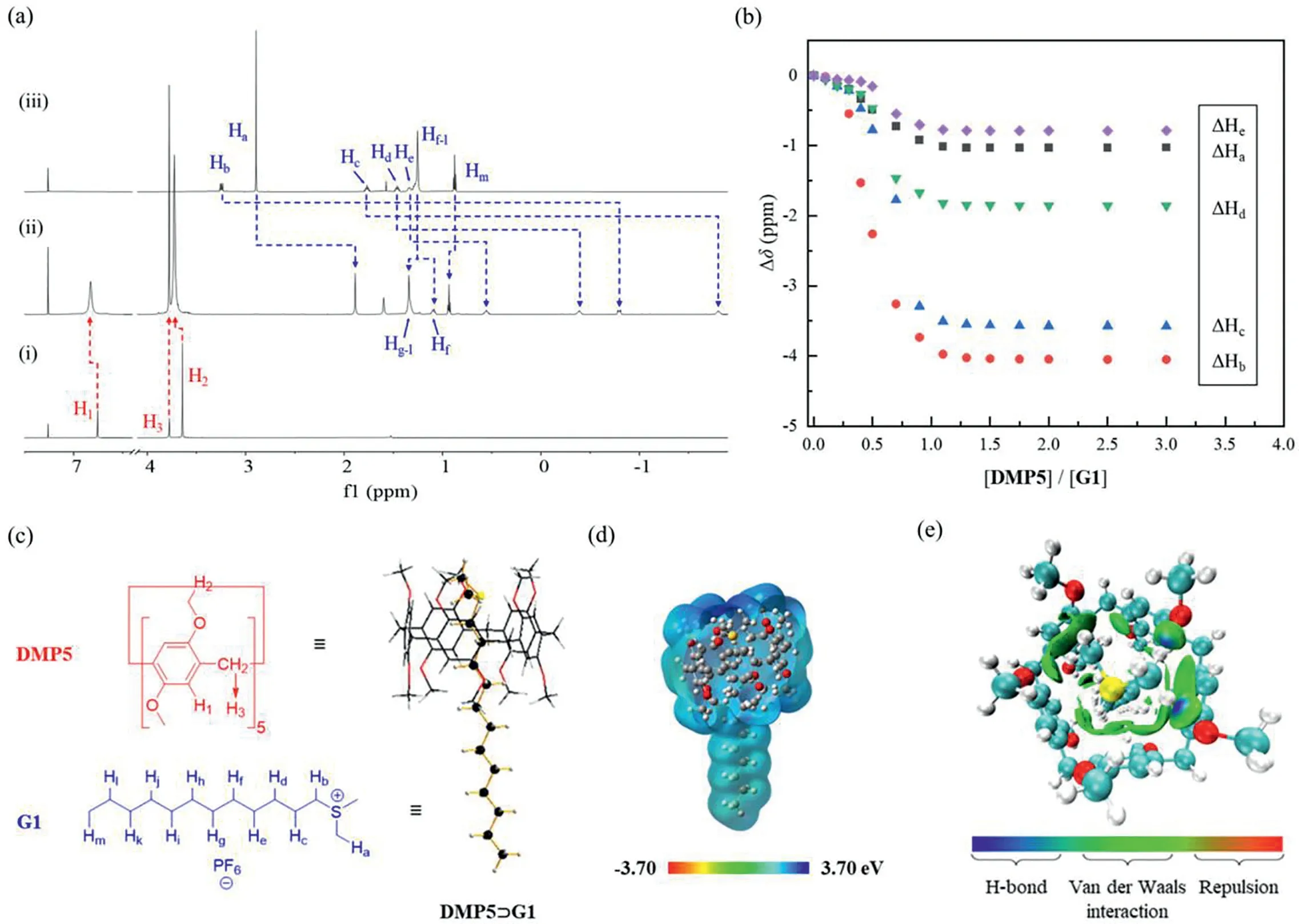
Fig.1.(a)Partial 1H NMR spectra of(i)10.0 mmol/L DMP5,(ii)10.0 mmol/L DMP5+5.0 mmol/L G1,(iii)10.0 mmol/L G1 in CDCl3(600 MHz,298 K);(b)Normalized 1 H NMR chemical shifts(Δδ=δobsd-δbound)of Ha-He protons in G1 at a concentration of 10.0 mmol/L upon addition of DMP5(0-3.0 mol equiv.);(c)The side view of the energy-optimized structure of DMP5⊃G1;(d)The molecular electrostatic potential(ESP)surfaces of DMP5⊃G1;(E)The top-down view of the noncovalent binding surfaces of DMP5⊃G1 by IGM method.Isosurfaces coloured according to the BGR scheme over the range−0.05 Herein,we reported a new supramolecular polymer network by mixing a copolymer with pendant pillar[5]arenes groups and a bis(sulfonium)diction guest(Scheme 1).The interactions between pillar[5]arenes and sulfonium salts were firstly systematically investigated through the model host and guest.Then we use reversible addition-fragmentation chain transfer polymerization(RAFT)methods to prepare the target copolymer.Compared to the copolymer,the obtained supramolecular polymer network exhibited great changes in NMR spectroscopy and viscosity property.Moreover,the supramolecular polymer network could be dissociated by different external stimuli including temperature and competing host/guest reagents. Scheme 1.Representation of supramolecular polymer network constructed by copolymer poly-P[5]A and bis(sulfonium)guest G2. 1,4-Dimethoxypillar[5]arenes(DMP5)and dodecyl dimethyl sulfonium hexafluorophosphate(G1)were chosen as the model molecules(Fig.1c).NMR titration experiments were firstly carried out to investigate the interactions between DMP5 and G1(Figs.1a and b and Fig.S4-S7 in Supporting information).The addition of DMP5 to G1 in CDCl3showed significant changes of the magnetic environments of the most protons in DMP5 and G1(Fig.1a).Only one set of peaks on the NMR time scale indicated the fast-exchange complexation.The plots were constructed to exhibit the normalized chemical shift changes(Δδ=δobsd-δbound)for the protons of DMP5 and G1 as a function of the increasing concentration of DMP5 in the solution of G1(Fig.1b and Fig.S4 in Supporting information).The phenyl protons H1and methyl protons H3on DMP5 respectively shifted downfield from 6.76 ppm to 6.88 ppm and 3.65 ppm to 3.78 ppm,while no obvious chemical shift changes of the methylene protons H2were observed.The differences of the chemical shift changes for each proton of G1 revealed their positions in the cavity of DMP5.The protons Hband Hcshowed greater upfield shift changes(Δδ≈4.05 and 3.57 ppm,respectively),which suggested that they inhabited the inner aromatic cavity of DMP5.However,the methyl protons Hmexhibited small downfield shift changes from 0.88 ppm to 0.94 ppm,indicating that they were located in the deshielding regions of DMP5.These phenomena suggested the threading of the line guest G1 into the cavity of DMP5.The mole ratio plot based on the chemical shift changes of Hmon G1 indicated a 1:1 complexation stoichiometry,while the association constant(Ka)was then calculated to be 4.11×103L/mol by nonlinear least-squares analysis(Figs.S5-S7 in Supporting information).The electrospray ionization mass spectrum was performed to study the host-guest complex(Fig.S8 in Supporting information).A peak corresponding to[DMP5⊃G1-PF6]+was observed atm/z981.5545.2D NOESY spectrum was also performed to confirm the complexation model(Fig.S9 in Supporting information).The cross peaks of H1and Hb-dsupported the complete inclusion of the sulfonium salts unit into the cavity of DMP5.Since DMP5 provides a rigid andπ-rich cavity,the cation-πinteractions between DMP5 and G1 should be the main driving forces[44,45]. To deeply understand the formation mechanism of the complex,the optimized structures of DMP5,G1 and the complex DMP5⊃G1 were obtained by density functional theory(DFT)studies at the B3LYP/6-31G(d,p)level using the Gaussian 09 package suite[46],Multiwfn software version 3.8(Fig.1c and Fig.S10 in Supporting information)[47].Compared to DMP5,the symmetric structure of the DMP5 of the complex had slightly distorted,indicating the interactions existed between DMP5 and G1.Fig.1d and Fig.S11(Supporting information)showed the HOMO,LUMO and electrostatic surface potential(ESP)maps of DMP5,G1 and the complex DMP5⊃G1.Both HOMO and LUMO of DMP5 showed uniform distributions,while in the complex DMP5⊃G1,the distributions of the HOMO and LUMO became intricate.The cavity of DMP5 showed negative charge distributions,while G1 showed positive charge distributions on the sulfonium moiety.In the complex DMP5⊃G1,the positive charge distributions of the DMP5 fragment were significantly increased because of the charge transfer from G1 to DMP5.So DMP5 could combine with G1,forming cation-πinteractions[48,49].Then the noncovalent interaction(NCI)analyses were carried out to reveal the supramolecular interactions between DMP5 and G1 by the Independent Gradient Model approach(Fig.1e and Fig.S12 in Supporting information)[50].The NCI graph clearly showed multiple C-H···O hydrogen-bonding interactions and van der Waals interactions between DMP5 and G1. These evidences suggested the good binding ability of DMP5 with G1 and drove us to construct the supramolecular polymer network based on the non-covalent interactions between pillar[5]arenes and sulfonium salts. We used the RAFT polymerization method to generate the copolymer poly-P[5]A.Owing to the1H NMR spectrum of poly-P[5]A,the ratio of P[5]A units to MMA units was around 1:10,which was in good agreement with the feed ratio.The P[5]A units concentration was then regarded as the poly-P[5]A concentration.The GPC analysis revealed that poly-P[5]A had an average molecular weight of 53.0 kDa and PDI of 1.67(Fig.S2 in Supporting information).Meanwhile,TGA was used to evaluate the thermal stability of poly-P[5]A.The mass losses of poly-P[5]A in different temperature intervals showed only 1.2%mass loss when up to 200°C,indicating the good thermal stability of poly-P[5]A(Fig.S3 in Supporting information). Because the bis(sulfonium)guest G2 was hardly insoluble in chloroform but soluble in acetone,we investigated the host-guest interactions between pillar[5]arene-functionalized monomer 3 and G2 in CDCl3/CD3COCD3(2:1,v/v)solvent by1H NMR spectroscopy(Figs.S13-S15 in Supporting information).The protons Ha-fof G2 showed remarkable upfield shifts due to the shielding effect of 3,while slight downfield shifts were observed for protons H9-10of 3.The 2D NOESY NMR spectroscopy experiment also suggested the NOE correlations between Haof G2 and H9-10of 3.The binding behavior of 3 with G2 provided an opportunity for copolymer poly-P[5]A to form a supramolecular polymer network with G2. Since the pendant pillar[5]arene groups on poly-P[5]A could bind with the sulfonium moiety of G2 as demonstrated above,a supramolecular network based on pillar[5]arene-sulfonium recognition motifs could be constructed.Firstly,the1H NMR spectroscopy in the mixed solvent(CDCl3/CD3COCD3=2:1,v/v)showed direct evidences of the interactions between poly-P[5]A and G2(Fig.2a).The protons Ha-fof G2 showed remarkable upfield shifts due to the shielding effect of electron-rich cavities of pillararenes,while methoxy protons H2of poly-P[5]A showed slight downfield shifts.The pendant pillar[5]arene moieties kept good recognition property to sulfonium moieties despite the steric hindrance of the polymer backbone,showing similar behavior to the pillar[5]arene monomer 3.Since such noncovalent linking behavior would form larger supramolecular aggregates,two-dimensional diffusion-ordered1H NMR spectroscopy(DOSY)experiments were performed to investigate the formation of the supramolecular polymer network.Upon the addition of G2 into a solution of poly-P[5]A in CDCl3/CD3COCD3(2:1,v/v)solvent,the average diffusion coefficients(D)decreased from 2.60×10−10m2/s to 2.10×10−10m2/s,suggesting the emergence of the supramolecular polymer network with an increase in the average aggregation size(Fig.2b and Fig.S16 in Supporting information). Viscosity measurement is a reliable method to reflect the property of polymers[17].As the viscosity measurements showed,for the individual poly-P[5]A,the correlation between the specific viscosity and the concentration of poly-P[5]A was almost linear over the concentration range of 5.3-24.0 mmol/L,suggesting that no significant physical entanglements occurred.However,the specific viscosity of the mixture of poly-P[5]A and G2 increased exponentially with the increase of concentration when risen to around 15.3 mmol/L,indicating the self-assembly process occurred and formed the supramolecular polymer network(Fig.3)[51]. Scanning electron micrography(SEM)was employed to reveal the morphological transformation of the formation of the supramolecular network(Fig.4).The SEM image of poly-P[5]A presented a tightly arranged bubble film.After the addition of G2,the SEM image turned to intertangled porous structures,suggesting the formation of a cross-linked network.Transmission electron microscopy(TEM)experiments were also carried out to visualize the structures of the supramolecular polymer network,in which intertangled network structures could be observed(Fig.S17 in Supporting information). Therefore,the above results further confirmed the formation of the supramolecular polymer network owing to the host-guest interactions between pillar[5]arenes and sulfonium salts. Fig.2.(a)1H NMR spectra of(i)poly-P[5]A(10.0 mmol/L),(ii)poly-P[5]A(10.0 mmol/L)+G2(5.0 mmol/L),(iii)G2(10.0 mmol/L)in CDCl3/CD3COCD3(2:1,v/v,600 MHz,298 K);(b)2D DOSY spectra of poly-P[5]A(10.0 mmol/L),G2(5.0 mmol/L)and a mixture of poly-P[5]A(10.0 mmol/L)+G2(5.0 mmol/L)in CDCl3/CD3 COCD3(2:1,v/v,600 MHz,298 K). Fig.3.Specific viscosities of poly-P[5]A and a mixture of poly-P[5]A+G2(1:1 molar ratio)versus the concentration of poly-P[5]A. Fig.4.SEM images of(a)poly-P[5]A;(b)a mixture of poly-P[5]A+G2. Since the networks were formed through host-guest interactions between the pendant pillararenes and sulfonium groups,they could be dissociated by a variety of external stimuli.First,we investigated the dissociation of the supramolecular polymer network by adding competitive guest molecules.1,4-Butanedinitrile G3,which could strongly bind with pillar[5]arene[52],was chosen as the competitive guest.The transformation of the addition of G3 into the supramolecular polymer network was firstly studied by1H NMR spectroscopy(Fig.S18 in Supporting information).The protons of G3 exhibited remarkable upfield shift changes from 2.83 ppm to−1.33 ppm,while the protons of G2 recovered to the free uncomplexed state,suggesting that G3 could form a stronger complex with pillar[5]arene and lead to the dissociation of the supramolecular polymer network.The viscosity measurements further confirmed the transformation(Fig.5).With the presence of G3,the specific viscosity of the mixture decreased significantly due to the dissociation of supramolecular aggregates. Then,the dissociation of the supramolecular polymer network by competitive host molecules was investigated.With the addition of DMP5 into the solution of poly-P[5]A and G2,the viscosity of the solution decreased as expected,which was driven by the complexation of free DMP5 and G2(Fig.S19 in Supporting information).In addition,host-guest complexation is sensitive to temperature.When heated to 45°C,the protons Haof G2 exhibited small downfield shift changes,indicating heating behavior led to slight disassembly of the supramolecular polymer network(Fig.S20 in Supporting information). Fig.5.Specific viscosities of mixtures of poly-P[5]A+G2(2:1 molar ratio),poly-P[5]A+G2+G3(2:1:2 molar ratio)and poly-P[5]A+G3(1:1 molar ratio)versus the concentration of poly-P[5]A. Since we demonstrated the formation of the supramolecular polymer network,a supramolecular gel could be prepared based on poly-P[5]A and G2.However,directly mixing poly-P[5]A and G2(2:1 molar ratio)in CHCl3/CH3COCH3(2:1,v/v)solvent,we only obtained a slightly yellow solution with high viscosity even the concentration of poly-P[5]A was up to 125.0 mmol/L.Since the choice of solvent has a great influence on the preparation of a gel,we screened a variety of solvents.Mixing poly-P[5]A with G2 in pure chloroform,a supramolecular gel was finally obtained. The gel also could be dissociated by heating and the addition of G3 or DMP5.When G3 or DMP5 were directly added to the supramolecular gel and shook for a while,the gel immediately turn to a sol(Fig.6).And when heated to 50°C for several minutes,the gel was also dissociated into a transparent solution.Re-formation of the gel could be achieved by cooling and standing for a while. Fig.6.Reversible gel-sol transition of supramolecular gel. In conclusion,we have successfully developed a novel supramolecular networkviahost-guest interactions between the copolymer poly-P[5]A and bis(sulfonium)diction guest G2,which is the first time that the sulfonium salts have been introduced to fabricate a supramolecular polymer network.The network exhibited significant changes both in NMR spectroscopy and viscosity property compared to the copolymer poly-P[5]A.Moreover,based on the competition of host-guest interactions,the network structure can be destroyed by external stimuli,including competitive molecules and heating.This work is the marriage of supramolecular chemistry and polymer science,we hope this supramolecular network system may give a new way to develop novel multi stimuli-responsive materials in the future.Further exploring of functional supramolecular network systems based on pillar[5]arenes and sulfonium salts derivatives is now ongoing in our laboratory. Declaration of competing interest The authors declare that they have no known competing financial interests or personal relationships that could have appeared to influence the work reported in this paper. Acknowledgment This work was supported by National Natural Science Foundation of China(Nos.21702153 and 21801194). Supplementary materials Supplementary material associated with this article can be found,in the online version,at doi:10.1016/j.cclet.2022.03.103.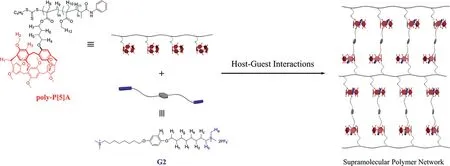
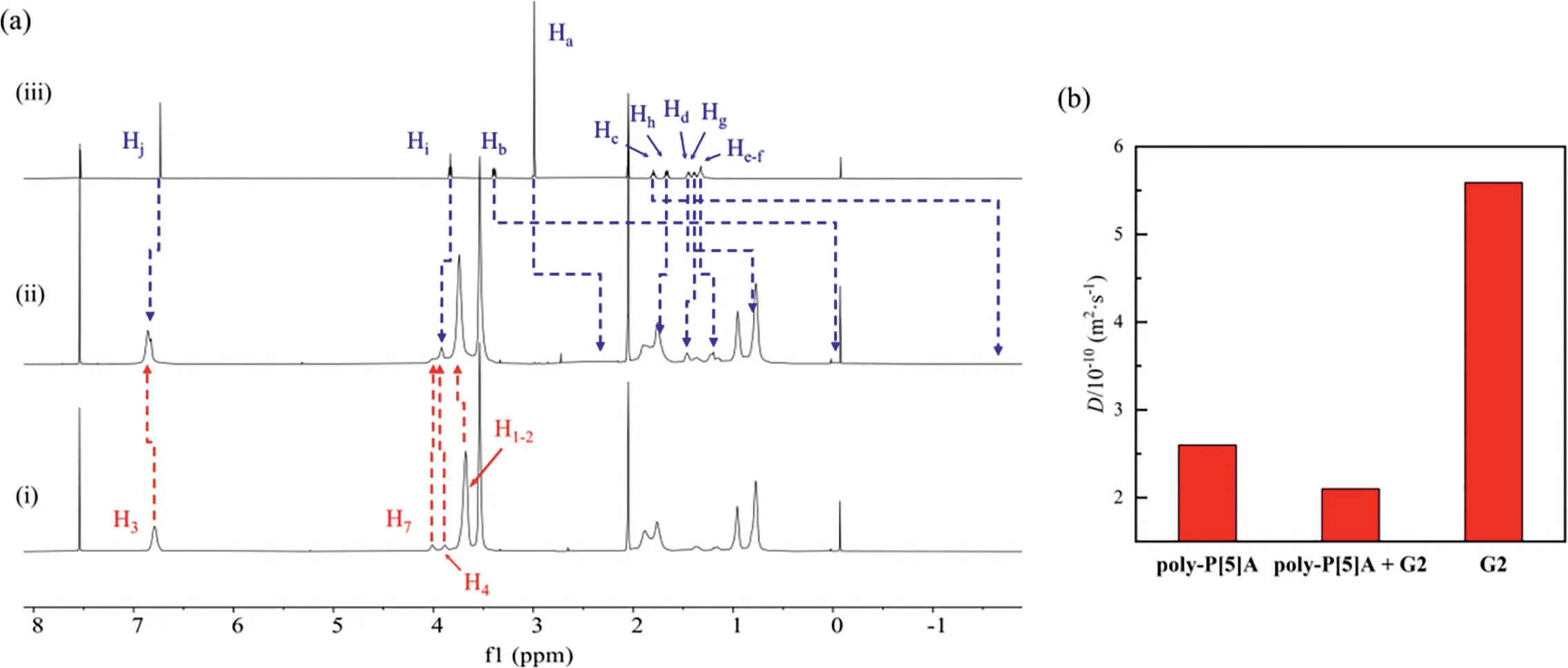


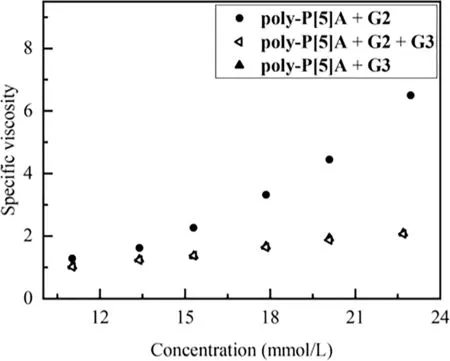
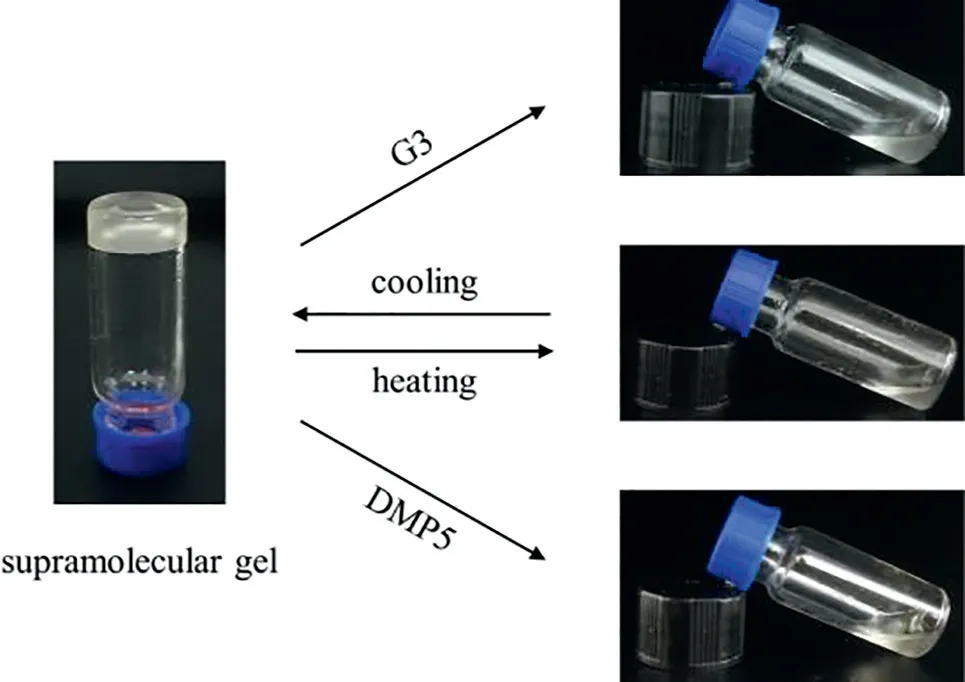
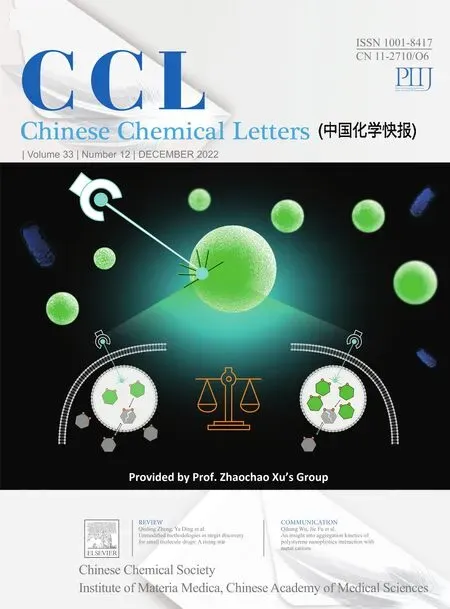 Chinese Chemical Letters2022年12期
Chinese Chemical Letters2022年12期
- Chinese Chemical Letters的其它文章
- Diverse strategic approaches en route to Taxol total synthesis
- Recent advances in gold-complex and chiral organocatalyst cooperative catalysis for asymmetric alkyne functionalization
- Unmodified methodologies in target discovery for small molecule drugs:A rising star
- Recent advances in single-crystalline two-dimensional polymers:Synthesis,characterization and challenges
- Environmental applications of graphene oxide composite membranes
- Recent advances in the application of metal organic frameworks using in advanced oxidation progresses for pollutants degradation
